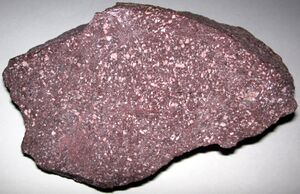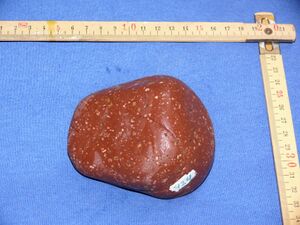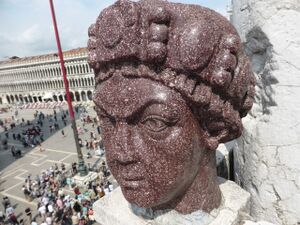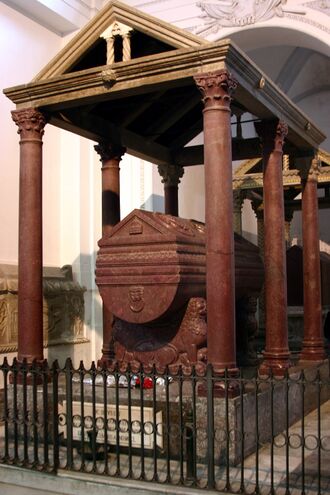صخر سماقي (جيولوجيا)

Porphyry ( /ˈpɔrfəri/ POR-fə-ree) is a textural term for an igneous rock consisting of coarse-grained crystals such as feldspar or quartz dispersed in a fine-grained silicate rich, generally aphanitic matrix or groundmass. The larger crystals are called phenocrysts.[1] In its non-geologic, traditional use, the term porphyry refers to the purple-red form of this stone, valued for its appearance.
The term porphyry is from the Ancient Greek πορφύρα (porphyra), meaning "purple". Purple was the color of royalty, and the "imperial porphyry" was a deep purple igneous rock with large crystals of plagioclase. Some authors claimed the rock was the hardest known in antiquity.[2] Thus, "imperial"-grade porphyry was prized for monuments and building projects in Imperial Rome and thereafter.
Subsequently, the name was given to any igneous rocks with large crystals. The adjective porphyritic now refers to a certain texture of igneous rock regardless of its chemical and mineralogical composition. Its chief characteristic is a large difference in size between the tiny matrix crystals and the much larger phenocrysts. Porphyries may be aphanites or phanerites, that is, the groundmass may have microscopic crystals as in basalt, or crystals easily distinguishable with the eye, as in granite. Most types of igneous rocks display some degree of porphyritic texture.
التشكل
Most igneous rocks have some degree of porphyritic texture. This is because most magma from which igneous rock solidifies is produced by partial melting of a mixture of different minerals.[3] When a body of magma slowly cools underground, the mineral with which the magma is most saturated begins crystallizing from the magma first, forming phenocrysts. The phenocrysts usually have plenty of room for growth, and form large, well-shaped crystals with characteristic crystal faces (euhedral crystals). If the partially crystallized magma is then erupted to the surface, the remainder of the magma crystallizes much more rapidly to form the fine-grained or glassy groundmass.[4]
However, porphyry can form even from magma that completely solidifies while still underground. The groundmass will be visibly crystalline, though not as coarse-grained as the phenocrysts. The crystallization of the phenocrysts changes the composition of the remaining liquid magma, moving it closer to the eutectic. The eutectic is the composition at which all the remaining minerals in the magma crystallize at a single temperature. The simultaneous crystallization of the remaining minerals produces the finer-grained groundmass.[4]
The significance of porphyritic texture as an indication that magma forms through partial melting was first recognized by the Canadian geologist, Norman L. Bowen, in 1928.[5][4]
Porphyritic texture is particularly common in andesite, with the most prominent phenocrysts typically composed of plagioclase feldspar.[6][7] Plagioclase has almost the same density as basaltic magma, so plagioclase phenocrysts are likely to remain suspended in the magma rather than settling out.[8]
Rhomb porphyry
Rhomb porphyry is a volcanic rock with gray-white large porphyritic rhombus-shaped phenocrysts embedded in a very fine-grained red-brown matrix. The composition of rhomb porphyry places it in the trachyte–latite classification of the QAPF diagram.[9]
Rhomb porphyry is found in continental rift areas, including the East African Rift (including Mount Kilimanjaro),[10] Mount Erebus near the Ross Sea in Antarctica,[11] the Oslo graben in Norway,[9] and south-central British Columbia.[12]
الاستخدام في الفن والعمارة

العصر العتيق والبيزنطي
Roman and late Roman imperial sarcophagi
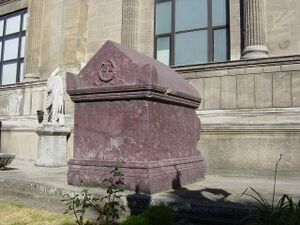
Porphyry sarcophagi in post-Roman Western Europe
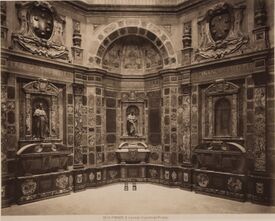
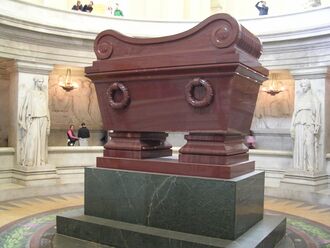
الاستخدامات الحديثة
In countries where many automobiles have studded winter tires such as Sweden, Finland, and Norway, it is common that highways are paved with asphalt made of porphyry aggregate to make the wearing course withstand the extreme wear from the spiked winter tires.[13]
انظر أيضاً
المصادر
- ^ Troll, Valentin R.; Chadwick, Jane P.; Ellam, Robert M.; McDonnell, Susan; Emeleus, C. Henry; Meighan, Ian G. (November 2005). "Sr and Nd isotope evidence for successive crustal contamination of Slieve Gullion ring-dyke magmas, Co. Armagh, Ireland". Geological Magazine (in الإنجليزية). 142 (6): 659–68. doi:10.1017/S0016756805001068. ISSN 1469-5081.
- ^ porphyry. New York & Oxford: Oxford University Press. 1991. p. 1701. ISBN 0195046528.
{{cite encyclopedia}}:|work=ignored (help) - ^ Philpotts, Anthony R.; Ague, Jay J. (2009). Principles of igneous and metamorphic petrology (2nd ed.). Cambridge, UK: Cambridge University Press. p. 16. ISBN 9780521880060.
- ^ أ ب ت Philpotts & Ague 2009, pp. 199-200.
- ^ Bowen, N.L. (1928). The evolution of the igneous rocks. Princeton University Press. ASIN B01K2DN0N8.
- ^ Blatt, Harvey; Tracy, Robert J. (1996). Petrology : igneous, sedimentary, and metamorphic (2nd ed.). New York: W.H. Freeman. p. 57. ISBN 0716724383.
- ^ Philpotts & Ague 2009, p. 376.
- ^ Philpotts & Ague 2009, p. 321.
- ^ أ ب Corfu, Fernando; Larsen, Bjørn Tore (December 2020). "U-Pb systematics in volcanic and plutonic rocks of the Krokskogen area: Resolving a 40 million years long evolution in the Oslo Rift". Lithos. 376–377: 105755. doi:10.1016/j.lithos.2020.105755. hdl:10852/83877.
- ^ Nonnotte, Philippe; Guillou, Hervé; Le Gall, Bernard; Benoit, Mathieu; Cotten, Joseph; Scaillet, Stéphane (June 2008). "New K–Ar age determinations of Kilimanjaro volcano in the North Tanzanian diverging rift, East Africa". Journal of Volcanology and Geothermal Research. 173 (1–2): 99–112. doi:10.1016/j.jvolgeores.2007.12.042.
- ^ McIver, JR; Gevers, T.W. (1970). "Volcanic vents below the Royal Society Range, Central Victoria Land, Antarctica". South African Journal of Geology. 73 (2): 65–88.
- ^ Ross, John V. (1 August 1974). "A Tertiary Thermal Event in South-Central British Columbia". Canadian Journal of Earth Sciences. 11 (8): 1116–1122. doi:10.1139/e74-106.
- ^ Lundqvist, Thomas (2009). Porfyr i Sverige: En geologisk översikt (in السويدية). pp. 42–43. ISBN 978-91-7158-960-6.
وصلات خارجية
- Pictures of the Mons Porphyrites, Red Sea, Egypt.
- Rhomb porphyry lavas at the Wayback Machine (archived مايو 20, 2008)
- Flash showing rhomb porphyry formation at the Wayback Machine (archived ديسمبر 24, 2007)
 Chisholm, Hugh, ed. (1911). . دائرة المعارف البريطانية (eleventh ed.). Cambridge University Press.
Chisholm, Hugh, ed. (1911). . دائرة المعارف البريطانية (eleventh ed.). Cambridge University Press. {{cite encyclopedia}}: Cite has empty unknown parameter:|coauthors=(help)
- CS1 errors: periodical ignored
- CS1 السويدية-language sources (sv)
- Articles with hatnote templates targeting a nonexistent page
- Articles containing Ancient Greek (to 1453)-language text
- مقالات المعرفة المحتوية على معلومات من دائرة المعارف البريطانية طبعة 1911
- صخور سماقية
- صخور بركانية
- صخور نارية
- خامات نحت
- Stone (material)
